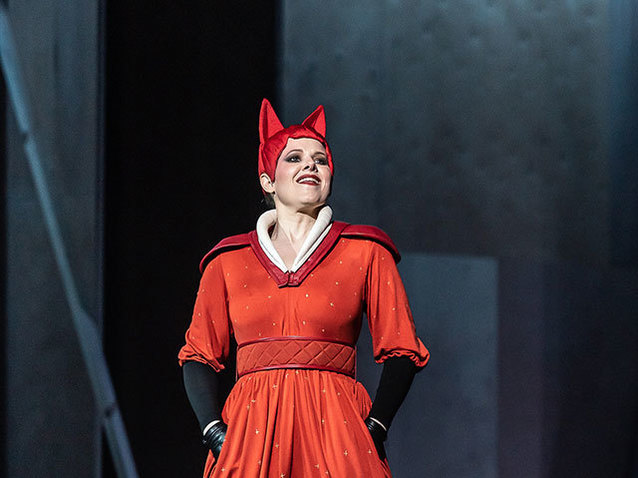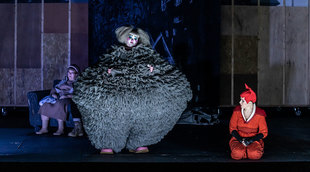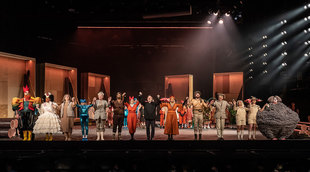 © (c) Clive Barda
© (c) Clive Barda
Composed between 1921 and 1923, Leoš Janáček’s The Cunning Little Vixen is based on the serialised novella Liška Bystrouška by Rodolf Těsnohlídek of 1920. This first appeared in the newspaper Lidové noviny, with illustrations by Stanislav Lolek, and Janáček adapted its words to arrive at the final libretto for the opera. A more literal translation of the Czech title would be Tales of Vixen Sharp-Ears, and the story tells of the adventures of this Vixen as she is caught and chained up by a Forester, escapes from his clutches and has children with a Fox before finally being shot dead. It represents, however, a far wider exploration of the cycle of life and death as a host of other animals appear alongside some humans, and the Forester, despite always claiming he wants to kill the creature, reveals a special affection for the Vixen.
The Cunning Little Vixen is, with the exception of The Excursions of Mr. Brouček, the lightest of all of the composer’s operas. Interpretations of the work still range from children’s entertainment to tragedy, but by no measure is it as dark or serious as Jenůfa or Káťa Kabanová. The score incorporates Moravian folk music and rhythms, while Janáček also wove into it what would be some of his most experimental opera concepts such as ballet, mime and orchestral interludes. At the composer’s request, the final scene from the piece was performed at his funeral in 1928.
In Jamie Manton’s new production for English National Opera, the stage itself is filled with logs arranged into neat triangular piles or placed in large containers. This suggests a tension between the perceived wholesomeness of the forest and the seemingly industrial scale of the tree felling, with the overall style of the staging also emphasising this. In Tom Scutt’s set the back and wings of the Coliseum stage are clearly visible, so that the contrast between the magic of the theatre and the practicalities that go behind generating it (since we can see all the scaffolding and lights) is highlighted. With the scene changes occurring in broad daylight and being an integral part of the drama, there is a touch of the Brechtian about the staging that is entirely appropriate for the work. This is because, with its plethora of animals and element of fantasy, the opera is designed to be colourful and innovations such as this only make it more so.
In fact, much of the production’s success is vested in little touches here and there. For example, banners hang from horizontal logs suspended from the ceiling. At the beginning the largest of these portrays a baby in the womb, thus highlighting the origins of life, and as the picture is scrolled downwards other images suggest the cycle of life as they relate to the various settings or seasons in the plot. At the end, when winter gives way to spring once more, the Forester pulls a further sheet from this banner across the floor as if breathing new life into the forest’s carpet.
In this production, when the Forester catches the Vixen he tellingly keeps her inside his house at first, and only moves her out to the courtyard when he decides to tie her up. When she is in his sitting room, which is complete with television, huge plywood boards are pushed tight together that towards their top reveal a monochrome panorama of rivers and hills. This proves to be both a simple and effective way of signifying entrapment, as well as what lies in the wide world beyond. It is also revealing that when the Priest (Clive Bayley), Forester and Schoolmaster (Alan Oke) are in the inn, where they are very nearly ‘hooked up’ to the beer, they sit on logs of different sizes alluding to their varying levels of masculinity.
A few changes are made to the plot so that while normally the Vixen kills all of the Hens when she escapes from the Forester’s home, here most of them survive and come with her. They then act as support when the Vixen takes over the Badger’s sett, singing the lines more usually handed simply to Forest Creatures, and thus emphasising the solidarity of the animals.

ENO's The Cunning Little Vixen 2022, Pumeza Matshikiza, Sally Matthews
(c) Clive Barda

ENO's The Cunning Little Vixen 2022, Madeleine Shaw, Claire Barnett-Jones,
Sally Matthews (c) Clive Barda
Most productions of The Cunning Little Vixen make the costumes conceptual, to suggest human traits in the animals, rather than entirely literal. This version is no exception, but overall they tend towards portraying each animal more closely than in many others. The Frog’s costume is quite playful but does portray the creature as we would think of it, and while the Vixen dons fingerless gloves she does sport obvious pointed ears and a tail. This contrasts with productions where, for example, her fur becomes a separate entity that is worn as an accessory, just as a person might wear it. It is, however, the Hens’ costumes that can really be taken on a multitude of levels. Their white frilly dresses, yellow tights and red and yellow hats that resemble crests make for a fairly accurate depiction of a white hen. However, their clothes also suggest they are subservient brides, only there to fulfil the Cock’s needs, while when the Vixen marries the Fox (Pumeza Matshikiza) these dresses enable them to become the bridesmaids. One of the most lavish costumes is donned by Claire Barnett-Jones as the Dog, with the huge furry ball that she wears being the very embodiment of puffed-up importance.
Conductor Martyn Brabbins brings an excellent combination of lushness and lightness, and of drive and sensitivity, to Janáček’s wondrous score. The large ensemble cast, which includes children, is strong across the board, but the absolute standout performances come from Sally Matthews as the Vixen and Lester Lynch as the Forester. Matthews, with a soprano that glistens, captures to perfection the Vixen’s alertness, intelligence, confidence and playfulness, and consequently makes her feel very sensual without ever overdoing this angle. Lynch, with his firm and commanding baritone, provides an extremely sensitive portrayal of the Forester. When he discovers the Poacher (Ossian Huskinson) is to marry the girl with whom he is infatuated the shock and sorrow he feels are clear enough, even though he conveys these emotions very subtly. His rapport with Matthews is also excellent, and when he decides to tie the Vixen up he gazes into her eyes in a way that tells us all we need to know about his feelings for her. At this point, he even removes the hat that bears her ears, as if wanting to make her more human, before dropping this again. This is because deep down he knows that, while he would love it to be otherwise, the Vixen is the Vixen who can neither be tamed or his. The matinee performance on 26 February will be a Relaxed Performance conducted by Olivia Clarke.
By Sam Smith
The Cunning Little Vixen | 20 February – 1 March 2022 | London Coliseum
the 22 of February, 2022 | Print

Comments